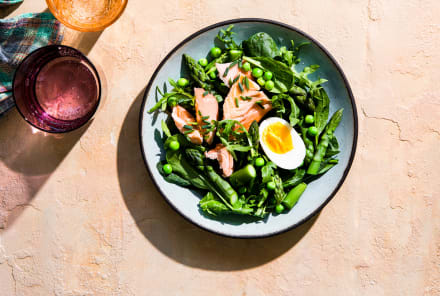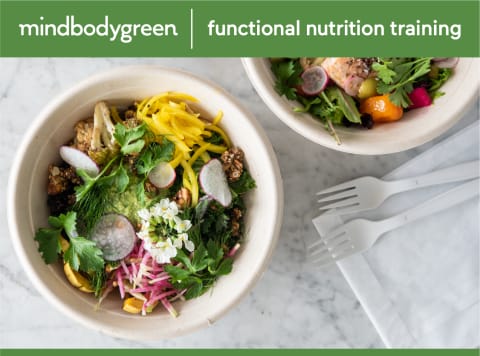Advertisement
Intermittent Fasting Meal Plan: Here's Exactly When & What To Eat


Intermittent fasting is a style of eating in which you go without food for a certain amount of time each day.
To help you navigate your day, here's a guide to how to schedule your meals while intermittent fasting.
And just remember: Although this eating plan is structured around when you eat, what you eat is still important.
During the periods of time when you're eating, you'll want to focus on healthy fats, clean protein, and carbohydrates from whole food sources.
How to schedule meals when you are intermittent fasting.
While the idea of fasting can be overwhelming, especially if you haven't done it before, intermittent fasting can actually be a lot easier than many other types of eating plans.
Once you start your intermittent fasting journey, you'll most likely find that you feel fuller longer and can keep the meals you do eat very simple.
There are a few different ways you can fast, so I broke up each of the different plans below into beginner, intermediate, and advanced along with a typical meal plan for each day.
The combination of nutrients will give you the energy you need to enhance the benefits of your fasting journey.
Just make sure to take into account any individual food intolerances, and use this as a guide for your particular health case, and adjust from there.
Remember, intermittent fasting does not necessarily mean calorie-controlled, so be sure to eat according to your personal caloric needs.
1. The basic intermittent fasting meal plan for beginners.
If you are a beginner, starting by only eating between the hours of 8 a.m. and 6 p.m. is a great way to dip your toes into the fasting waters.
This plan allows you to eat every meal plus some snacks but still get in 14 hours of fasting within a 24-hour period.
Breakfast: Green Smoothie at 8 a.m.
After fasting, I like to ease into my day of eating with a smoothie since it is a little easier for my gut to digest.
You'll want to go for a green smoothie instead of a high-sugar fruit smoothie to avoid starting your day on a blood-sugar roller coaster. Add in lots of healthy fats to keep you going until lunch!
Ingredients:
- 1 avocado
- 1 cup coconut milk
- 1 small handful blueberries
- 1 cup spinach, kale, or chard
- 1 tablespoon chia seeds
Method:
Add all ingredients into blender, blend, and enjoy!
Lunch: Grass-Fed Burgers at 12 p.m.
Grass-fed liver burgers are one of my favorite choices for lunch during the week, and they are extremely easy to prep to have throughout the entire week.
You can eat this on top of a bed of dark leafy greens with a simple homemade dressing for a meal packed with B vitamins for healthy methylation (how our body operates mentally and physically) and detox pathways.
Ingredients:
- ½ pound ground grass-fed beef liver
- ½ pound ground grass-fed beef
- ½ teaspoon garlic powder
- ½ teaspoon cumin powder
- Sea salt and pepper to taste
- Desired cooking oil
Method:
- Mix together all ingredients together in a bowl and form together desired-size patties.
- Heat cooking oil over skillet on medium-high heat.
- Cook burgers in skillet until desired doneness.
- Store in a container in the fridge and use within 4 days.
Snack: Cinnamon Roll Fat Bombs at 2:30 p.m.
Fat bombs will curb your sweet tooth and give you enough healthy fats to sustain you until dinner, and these are especially satisfying because they taste exactly like cinnamon rolls.
Ingredients:
- ½ cup coconut cream
- 1 teaspoon cinnamon
- 1 tablespoon coconut oil
- 2 tablespoons almond butter
Method:
- Mix together coconut cream and ½ teaspoon cinnamon.
- Line an 8-by-8-inch square pan with parchment paper and spread coconut cream and cinnamon mixture at the bottom.
- Mix together ½ teaspoon of cinnamon with coconut oil and almond butter. Spread over the first layer in the pan.
- Freeze for 10 minutes and cut into desired-size squares or bars.
Dinner: Salmon & Veggies at 5:30 p.m.
Salmon is an excellent source of omega-3 healthy fats, and dark green veggies like kale and broccoli are high in antioxidants.
Salmon is one of my personal favorites for its taste and nutrient density, and you can select any wild-caught seafood of your choice.
Serve alongside some of your favorite vegetables roasted in coconut oil, and you have a quick and easy superfood meal.
Ingredients:
- 1 pound salmon or other fish of choice
- 2 tablespoons fresh lemon juice
- 2 tablespoons ghee
- 4 cloves garlic, finely diced
Method:
- Preheat oven to 400°F.
- Mix together lemon juice, ghee, and garlic.
- Place salmon in foil and pour lemon and ghee mixture over the top.
- Wrap salmon with the foil and place on a baking sheet.
- Bake for 15 minutes or until salmon is cooked through.
- If your oven size allows, you can roast your vegetables alongside salmon on a separate baking sheet.
2. Intermediate fasting meal plan.
With this plan, you will be eating only between the hours of 12 p.m. and 6 p.m. for a full 18 hours of fasting within a 24-hour period.
I personally practice this plan during the workweek. I'm not a breakfast person, so I just enjoy a few cups of herbal tea to start my day.
Even though you are skipping breakfast, it's still important to stay hydrated.
Make sure to drink enough water. You can also have herbal tea, (Most experts agree coffee and tea don't break your fast.)
The catechins in tea have been shown to enhance the benefits of fasting by helping to further decrease the hunger hormone ghrelin1, so you can make it until lunch and not feel deprived.
Since you've increased your fasting period an extra four hours, you need to make sure your first meal (at noon) has enough healthy fats. The burger in the 8-to-6-window plan will work well, and you can add more fats in with your dressing or top with avocado!
Nuts and seeds make great snacks that are high-fat and can be eaten around 2:30 p.m.
Soaking these beforehand can help neutralize naturally occurring enzymes like phytates2 that can contribute to digestive problems. Eat dinner around 5:30 p.m., and just like in the 8-to-6-window plan, a dinner with some sort of wild-caught fish or another clean protein source with vegetables is a great option.
- First meal, 12 p.m.: Grass-fed burger with avocado
- Snack, 2:30 p.m.: Nuts and seeds
- Second meal, 5:30 p.m.: Salmon and veggies
3. Advanced: The modified 2-day meal plan.
For this plan, eat clean for five days of the week (you can pick whatever days you want). On the other two days, restrict your calories to no more than 700 each day.
Calorie restriction unlocks many of the same benefits3 as fasting for an entire day.
On your non-fasting days, you'll need to make sure you're getting in healthy fats, clean meats, vegetables, and some fruits, and you can structure your meals however best works for you.
On restricted days, you can have smaller meals or snacks throughout the day or have a moderate-size lunch and dinner and fast in the morning and after dinner.
Again, focus on healthy fats, clean meats, and produce. Apps can help you log your food and keep track of your calorie intake so you don't go over 700.
4. Advanced: The 5-2 meal plan.
On this plan you'll eat clean five days of the week but will not eat anything for two nonconsecutive days of the week.
For example, you can fast on Monday and Thursday but eat clean meals on the other days.
Food on these five days will look just like the rest of the fasting plans—healthy fats, clean meat sources, vegetables, and some fruit.
Keep in mind that this plan is not for beginners, and you should always talk to your doctor before starting any fasting regimen, especially if you are on medication or have a medical condition.
It is recommended that coffee drinkers maintain their morning coffee intake and that everyone who does an advanced fast stays properly hydrated.
- Monday: Fast.
- Tuesday: Eat healthy fats, clean meat sources, vegetables, and some fruit.
- Wednesday: Eat healthy fats, clean meat sources, vegetables, and some fruit.
- Thursday: Fast.
- Friday: Eat healthy fats, clean meat sources, vegetables, and some fruit.
- Saturday: Eat healthy fats, clean meat sources, vegetables, and some fruit.
5. Advanced: Every-other-day plan or alternate-day fasting.
Even though the alternate-day fasting (ADF) plan is advanced, it's very simple. Don't eat anything every other day.
Every other day, eat healthy fats, clean meat sources, vegetables, and some fruit, and then on your fasting days, you can consume water, herbal tea, and moderate amounts of black coffee or tea.
- Monday: Eat healthy fats, clean meat sources, vegetables, and some fruit.
- Tuesday: Fast.
- Wednesday: Eat healthy fats, clean meat sources, vegetables, and some fruit.
- Thursday: Fast.
- Friday: Eat healthy fats, clean meat sources, vegetables, and some fruit.
- Saturday: Fast.
- Sunday: Eat healthy fats, clean meat sources, vegetables, and some fruit.
With this information in hand, you should know exactly how to schedule meals when starting an intermittent fasting plan.
And while it might seem complicated at first, once you get into the habit of fasting, it will feel like second nature and fit pretty seamlessly into your days.
But always start slow and gradually work up to more advanced plans.
It's also important to remember that you might have some "off" days when intermittent fasting doesn't work for you. Listen to your body—if you need to eat outside of your typical window, it's OK! Just restart when you're feeling better. Want more fasting info? Here's our definitive guide to fasting, the four phases of fasting, and different types of fasting to explore.
Watch Next
Enjoy some of our favorite clips from classes
Enjoy some of our favorite clips from classes
What Is Meditation?
Mindfulness/Spirituality | Light Watkins
Box Breathing
Mindfulness/Spirituality | Gwen Dittmar
What Breathwork Can Address
Mindfulness/Spirituality | Gwen Dittmar
The 8 Limbs of Yoga - What is Asana?
Yoga | Caley Alyssa
Two Standing Postures to Open Up Tight Hips
Yoga | Caley Alyssa
How Plants Can Optimize Athletic Performance
Nutrition | Rich Roll
What to Eat Before a Workout
Nutrition | Rich Roll
How Ayurveda Helps Us Navigate Modern Life
Nutrition | Sahara Rose
Messages About Love & Relationships
Love & Relationships | Esther Perel
Love Languages
Love & Relationships | Esther Perel
What Is Meditation?
Box Breathing
What Breathwork Can Address
The 8 Limbs of Yoga - What is Asana?
Two Standing Postures to Open Up Tight Hips
How Plants Can Optimize Athletic Performance
What to Eat Before a Workout
How Ayurveda Helps Us Navigate Modern Life
Messages About Love & Relationships
Love Languages
Advertisement

I'm An RD & Here's How I Went From Eating 60 To 100 Grams Of Protein Daily
Molly Knudsen, M.S., RDN

The Benefits Of Supplementing With Magnesium (Especially If You're 60+)
Gretchen Lidicker, M.S.

I'm An RD & Here's How I Went From Eating 60 To 100 Grams Of Protein Daily
Molly Knudsen, M.S., RDN

The Benefits Of Supplementing With Magnesium (Especially If You're 60+)
Gretchen Lidicker, M.S.

I'm An RD & Here's How I Went From Eating 60 To 100 Grams Of Protein Daily
Molly Knudsen, M.S., RDN

The Benefits Of Supplementing With Magnesium (Especially If You're 60+)
Gretchen Lidicker, M.S.

I'm An RD & Here's How I Went From Eating 60 To 100 Grams Of Protein Daily
Molly Knudsen, M.S., RDN

The Benefits Of Supplementing With Magnesium (Especially If You're 60+)
Gretchen Lidicker, M.S.















